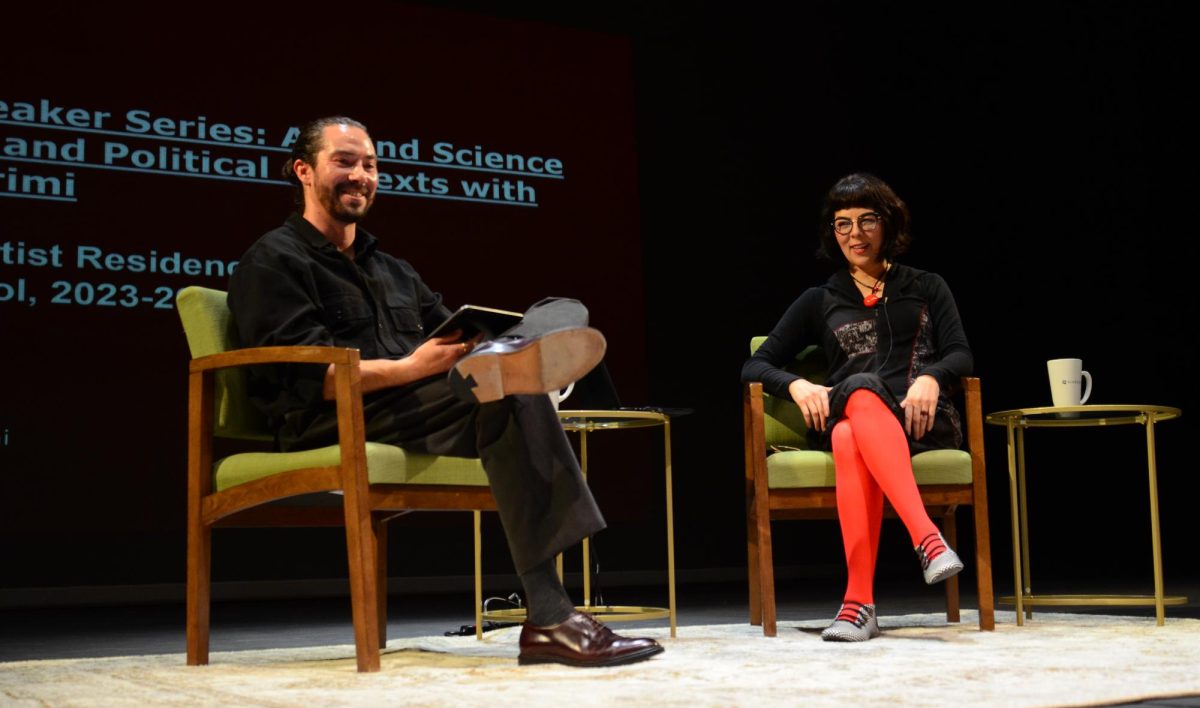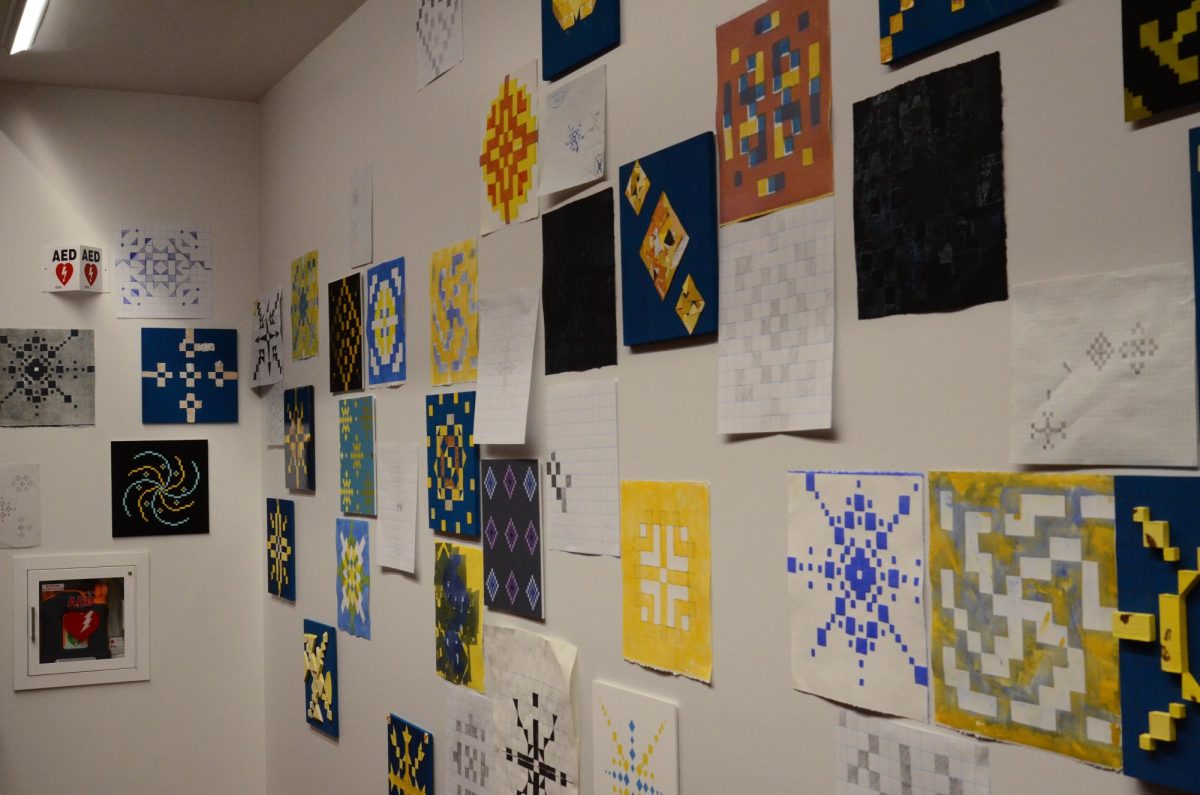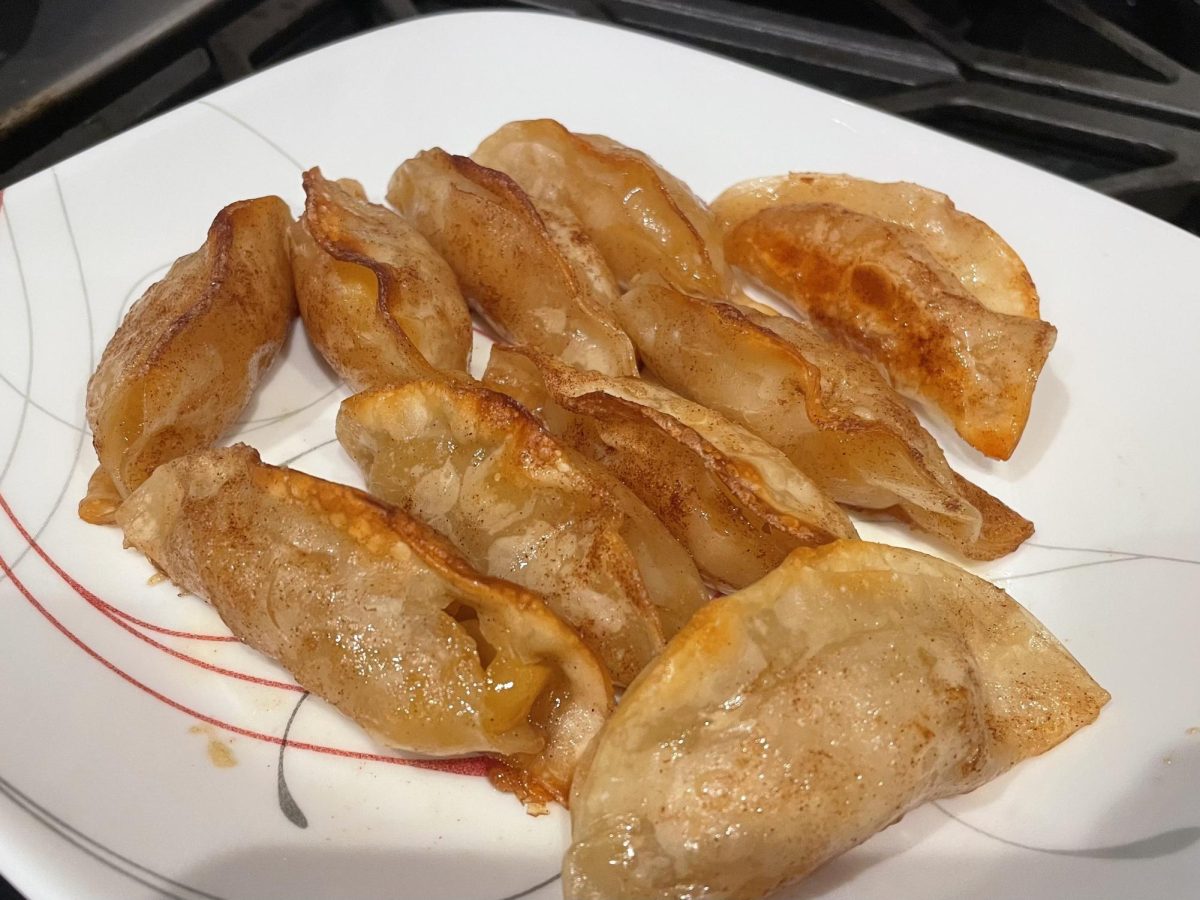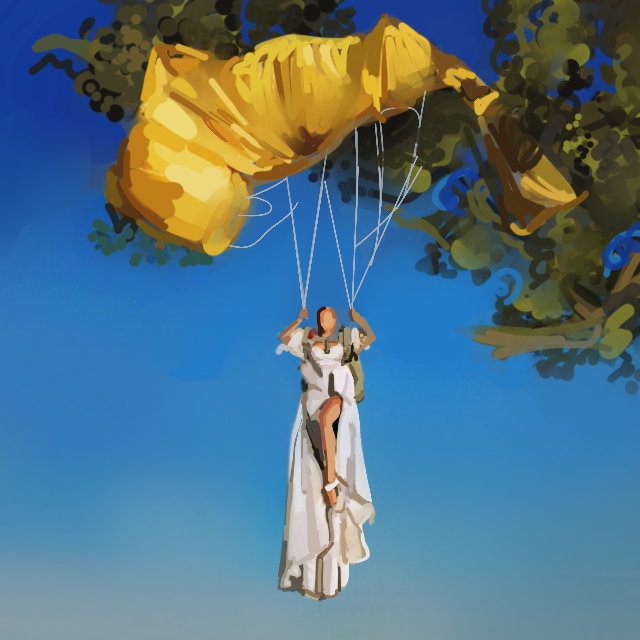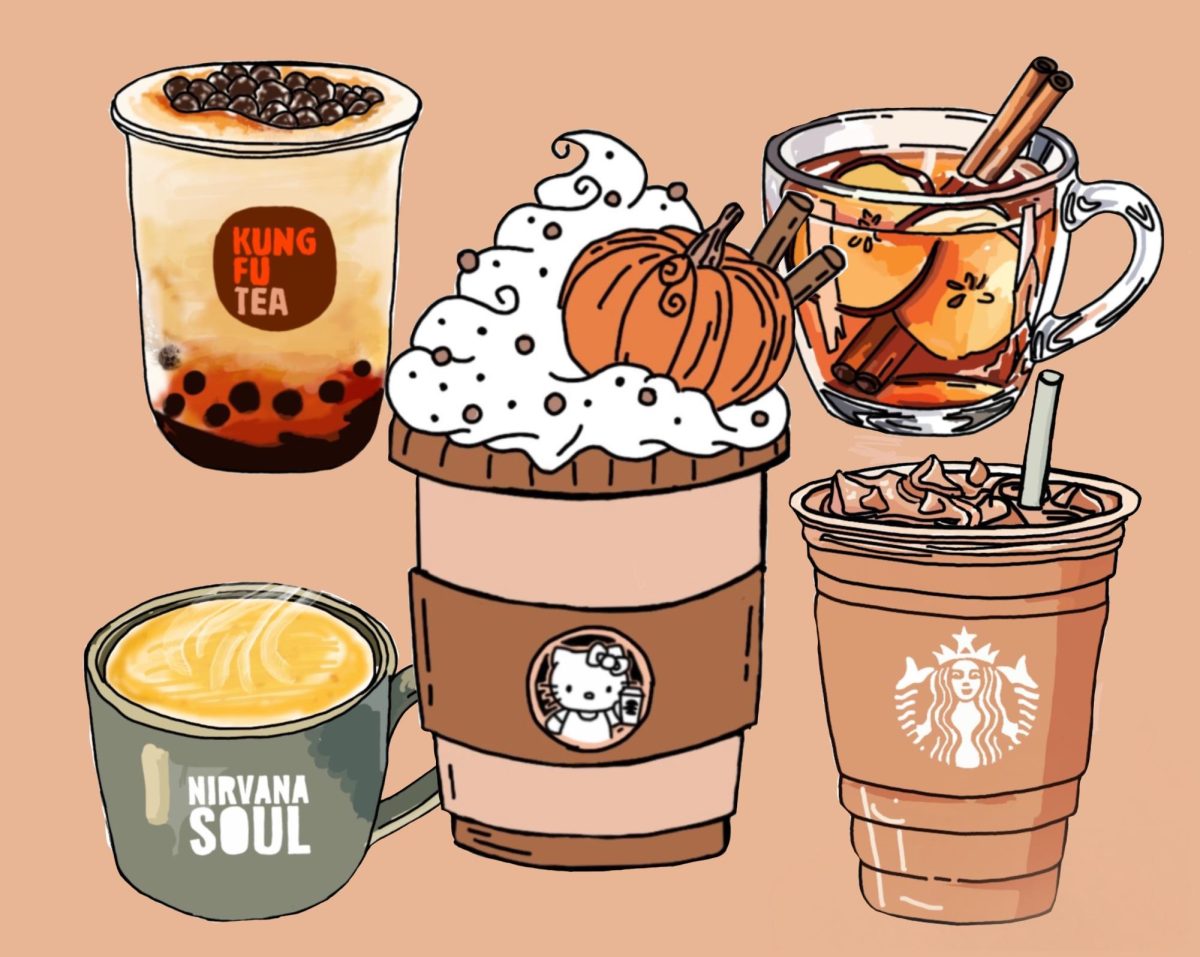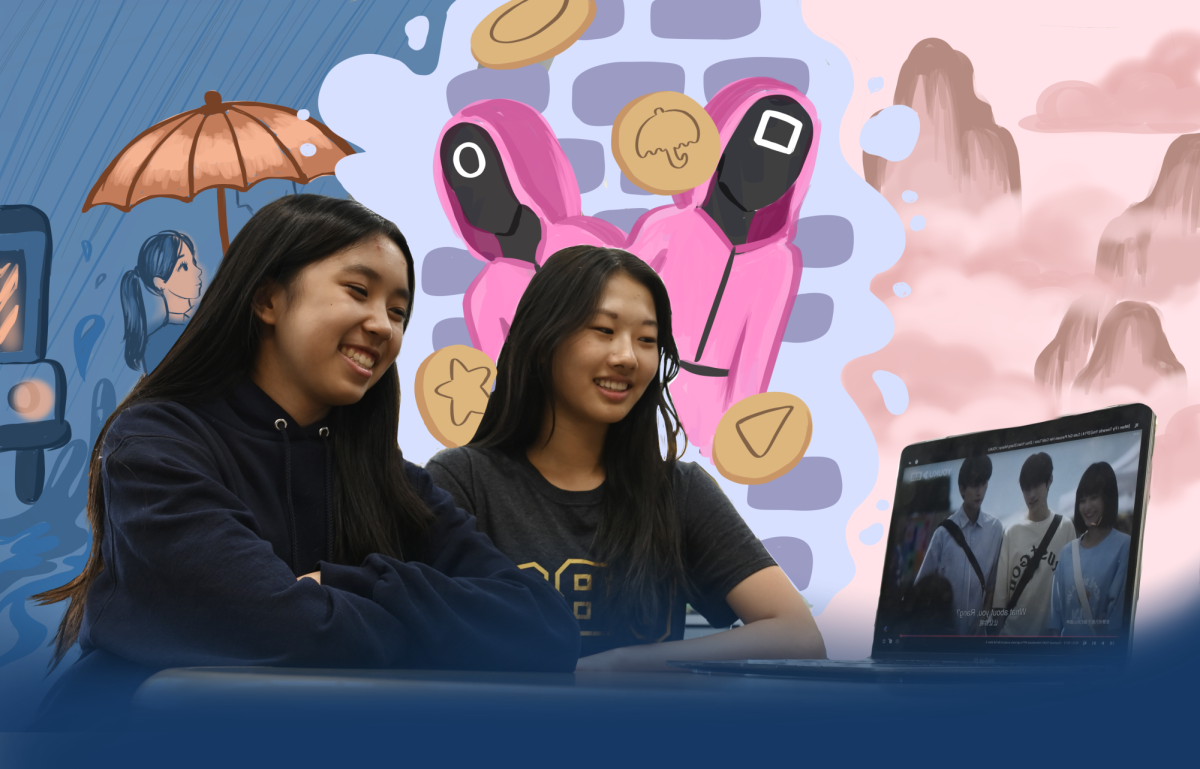2023 Dickinson Visual Arts Endowment Artist in Residence Pantea Karimi concluded her residency with a Q&A talk hosted by the Harker Speaker Series on Nov. 29 in the Patil Theater.
During the talk, titled “Art and Science in Historic and Political Conversations: A Conversation with Pantea Karimi,” upper school media arts teacher Joshua Martinez interviewed Karimi about the inspiration behind her work, life and RPAC exhibition “Context Lost.” Born in Shiraz, Iran, Karimih cited her mother, father and grandmother as the inspiration for her interest in art and history, medical botany and mathematics.
“My compulsion to explore the past is an investigation of my identity that simultaneously celebrates and protests my cultural heritage and my life experiences,” Karimi said. “The works that I’ve been doing surround not only my personal stories but also highlight these scientific and cultural and historic archival materials, often put into sociopolitical contexts.”
Karimi’s body of work draws from historical documents and early illustrated scientific manuscripts from Persian, Arab and European cultures. Through her installations, drawings and various Karimi aims to share Iranian history and culture with the world, especially because Iranian military and political conflicts have shrouded much of her home country’s heritage.
“I hope that the community sees the cultural and the historic archival materials I highlight from Iran first before the sociopolitical conflicts and issues we encounter,” Karimi said. “That’s why my exhibition is called ‘Context Lost.’ Because this is what people lose and do not see when they talk about Iran.”
During her residency, which began on Nov. 1, Karimi lectured at Harker art classes, held workshops for students and gave feedback to students working on their art portfolios for Harker classes and college. Because art is so often overlooked by Harker’s STEM-driven students and programs, Karimi’s work, which couples traditional art with science, allows students to expand their perception and appreciation for what art is.
Talk attendee and Honors Directed Portfolio student Julie Shi (12) helped design the promotional poster for Karimi’s residency. She appreciates the opportunity to directly speak to and learn from a successful artist like Karimi.
“When she visited our HDP class and was critiquing our pieces, she had a lot of amazing comments and insights from a professional artist,” Julie said. “She gave me a lot of advice for the ideas and composition for my art portfolio. It’s very amazing to hear her talk and hear the inner thoughts of an artist that’s on the level that she is.”
The incredible depth and visual versatility of Karimi’s work has garnered strong recognition. Prestigious institutions across the globe like the de Young Museum and Google have showcased Karimi’s artwork. Her works are held in private and public collections at YouTube, Stanford University and the NASA Ames Research Center.
“I came to the talk today because I’m really interested in art and I wanted to see what a professional artist is like,” attendee Zoe Fan (7) said. “It was really inspiring to see how she came up with these ideas, especially how she was influenced by her childhood and different parts of her culture.”
Karimi’s talk was part of the Harker Speaker Series, which aims to connect the Harker community with experts from various fields. Events like hers not only present students with valuable learning experiences but also allow members of the Harker community to make connections with and learn from influential people from the community at large. Attendees of Karimi’s talk included several major museum curators from San Jose.
“The Speaker Series element is really important for us to be able to invite outside members of the community to Harker to raise Harker’s profile and to bridge the gap between the school and the community,” Martinez said. It’s just really nice to be able to bring those people into Harker and to make that connection.”
As both an artist in residence and a Speaker Series presenter, Karimi synthesizes art and science in a visual representation of her own cultural heritage and emotions. Each of her pieces adapts scientific motifs to contextualize them within contemporary societal, geopolitical and environmental issues. Through the interconnected juxtaposition of traditional cultural aesthetics and syncretic imagery, Karimi’s art not only showcases her artistic versatility but drives forward a valuable perspective to the ongoing dialogue on cultural identity.
“I hope the audience takes away that integration of art and science has a point,” Karimi said. “It has enabled me to tell my story, it has enabled me to reveal archival materials, it has enabled me to tell the story of the sociopolitical conflicts and issues, all of this.”


















![“[Building nerf blasters] became this outlet of creativity for me that hasn't been matched by anything else. The process [of] making a build complete to your desire is such a painstakingly difficult process, but I've had to learn from [the skills needed from] soldering to proper painting. There's so many different options for everything, if you think about it, it exists. The best part is [that] if it doesn't exist, you can build it yourself," Ishaan Parate said.](https://harkeraquila.com/wp-content/uploads/2022/08/DSC_8149-900x604.jpg)




![“When I came into high school, I was ready to be a follower. But DECA was a game changer for me. It helped me overcome my fear of public speaking, and it's played such a major role in who I've become today. To be able to successfully lead a chapter of 150 students, an officer team and be one of the upperclassmen I once really admired is something I'm [really] proud of,” Anvitha Tummala ('21) said.](https://harkeraquila.com/wp-content/uploads/2021/07/Screen-Shot-2021-07-25-at-9.50.05-AM-900x594.png)







![“I think getting up in the morning and having a sense of purpose [is exciting]. I think without a certain amount of drive, life is kind of obsolete and mundane, and I think having that every single day is what makes each day unique and kind of makes life exciting,” Neymika Jain (12) said.](https://harkeraquila.com/wp-content/uploads/2017/06/Screen-Shot-2017-06-03-at-4.54.16-PM.png)








![“My slogan is ‘slow feet, don’t eat, and I’m hungry.’ You need to run fast to get where you are–you aren't going to get those championships if you aren't fast,” Angel Cervantes (12) said. “I want to do well in school on my tests and in track and win championships for my team. I live by that, [and] I can do that anywhere: in the classroom or on the field.”](https://harkeraquila.com/wp-content/uploads/2018/06/DSC5146-900x601.jpg)
![“[Volleyball has] taught me how to fall correctly, and another thing it taught is that you don’t have to be the best at something to be good at it. If you just hit the ball in a smart way, then it still scores points and you’re good at it. You could be a background player and still make a much bigger impact on the team than you would think,” Anya Gert (’20) said.](https://harkeraquila.com/wp-content/uploads/2020/06/AnnaGert_JinTuan_HoHPhotoEdited-600x900.jpeg)

![“I'm not nearly there yet, but [my confidence has] definitely been getting better since I was pretty shy and timid coming into Harker my freshman year. I know that there's a lot of people that are really confident in what they do, and I really admire them. Everyone's so driven and that has really pushed me to kind of try to find my own place in high school and be more confident,” Alyssa Huang (’20) said.](https://harkeraquila.com/wp-content/uploads/2020/06/AlyssaHuang_EmilyChen_HoHPhoto-900x749.jpeg)



